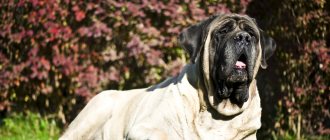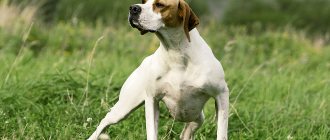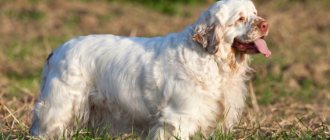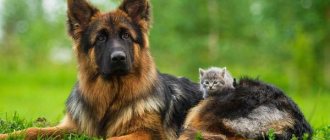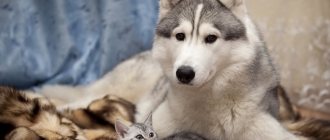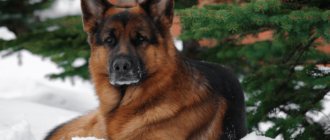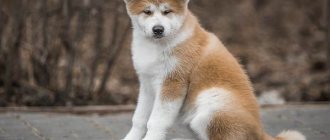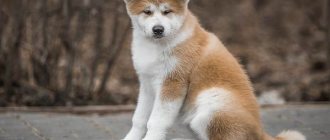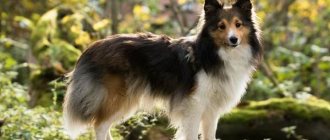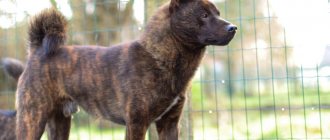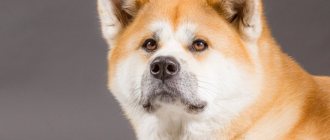Description and features
England is home to many of today's popular dogs, such as the beagle and border collie. It was in this country that the English Mastiff breed . Its second name is Great Dane. Without a doubt, this is one of the largest dogs in the world.
Initially, he was bred to guard the house and the people living in it. Experts believe that many centuries ago the British chained the mastiff to make it more ferocious. The dog, fenced off from people, tried to sniff them and attack some, but was restrained by a strong chain. Hence the rapid accumulation of negative energy and aggression.
It is not known exactly how the history of the Great Dane began. According to one version, mountain residents began to breed it. Moving over rocky terrain, the animal acquired physical and mental hardening, became strong and resilient.
Interesting! The English Mastiff was the favorite breed of the famous commander and conqueror Alexander the Great. He often surrounded himself with these powerful dogs and even took them with him into battle.
It is believed that the standard of this breed has changed many times. For example, when German soldiers invaded Britain in the 5th century, taking their war dogs with them, the Great Danes naturally transformed. They acquired their famous dark red mask on their muzzle precisely through crossing with German fighting dogs.
The peculiarity of the modern English mastiff is its pronounced phlegmatic nature. He never rushes, preferring to remain calm in almost any situation. As a companion pet, this is a great option. Ideal for older retirees who prefer leisurely and long walks.
Really needs early training. Prone to insubordination and laziness. If an elderly person gets an adult Great Dane, he will probably not be able to handle his upbringing and will not be able to teach him anything. A representative of the breed needs a patient owner who will become his teacher in life. He also wants to see his friend in this person.
An excellent watchman. He is characterized by such traits as vigilance, caution, slowness and determination. It can attack a person if he intends to cross the territory he protects. But, in a calm, non-coercive environment, it is completely safe.
Mastiff is one of the largest and heaviest dog breeds
He prefers passive rest to cheerful active play. Loves to be near the owner. A good and caring bodyguard. You should not think that the Great Dane is dangerous or mentally unstable. His behavior is quite predictable. In everyday life, such a dog is not only reliable, but also very gentle.
Possible diseases
Like any other large breed, English mastiffs live relatively short - from 7 to 10 years. However, these figures are considered good indicators. However, no matter how much the owner cares for his pet, there are a number of diseases that sometimes cannot be avoided.
Ailments that characterize the breed include problems with the musculoskeletal system. For example, the dog is characterized by hip dysplasia. However, this misfortune haunts all large representatives of dogs. The breed is also characterized by a type of arthrosis such as gonarthrosis of the knee joints. The reason lies in the fact that cartilage tissue wears out ahead of time.
The dog also suffers from problems with the gastrointestinal tract. These include volvulus of the stomach and intestines, intestinal obstruction, and bloating in the abdomen. The listed diseases do not require medical intervention and can be relatively easily solved with the right diet and daily routine.
There are also diseases that primarily affect male dogs, for example, urolithiasis. It is a consequence of the fact that the dog does not receive enough necessary vitamins and minerals in its diet. Therefore, it is very important to supplement the dog with such supplements and provide constant access to a bowl of clean drinking water.
A disease that affects the heart is a stretching of its walls, which has the medical name dilated cardiomyopathy. It may appear if the dog suffers from too intense exercise or is obese.
Eye diseases include entropion and eversion of the eyelids, which require surgical intervention. Cases of cataracts and retinal dystrophy are also common. In this situation, surgery will also be required.
Breed standard
The English Mastiff dog is one of the heaviest and tallest. Puppies grow up very quickly, gradually increasing their weight. The weight of an adult dog is from 80 to 85 kg, and the height is from 68 to 75 cm (males weigh more than females). The dog has a wide back, pronounced croup and loin. The body is elongated and powerful. Every muscle on the animal’s body is perfectly developed.
He has a wide and well-defined sternum. The rounded wide ribs are clearly visible on the stomach. The tail is sickle-shaped and set high. Usually it is motionless, but when the dog moves, it rises up. The stance of the high legs is parallel and straight. Rendered muscles run along the entire length of the limbs, with the hind muscles being especially well developed.
Lumpy paw pads. The claws are black and sharp. The dog's neck is short and its head is large. There are folds of skin on the throat. The jaw is powerful and well defined. The cheeks are thick and massive. According to the standard, the animal's lips should be black, and the front of the gums should be visible from its mouth, even if it is closed.
The head shape is square. The forehead is well defined. The cheekbones do not lean forward, but are clearly visible. When a dog is concentrating on something, many folds of skin form in the area of its forehead. There are also brow ridges. The nose is flattened, but large, dark in color. The bite of the teeth is correct.
The English Mastiff in the photo looks serious due to his deep-set dark eyes. They are covered from above by a dense fold of skin. On the animal's face, the eyes are located far from each other. The dog has short hair that is rough to the touch. There is an undercoat, it is softer. Representatives of the breed are characterized by the following color variations:
- Red-black (most common).
- Apricot.
- Brindle.
- Silver with tan marks.
Mastiffs have a calm and balanced character.
The Great Dane moves very confidently, slowly. Let us list the defects of the breed:
- Ears sticking up.
- Absence of a “mask” on the face.
- Lack of pigmented areas on the lips and nose.
- Different color.
- Tongue protruding from a closed mouth.
- Height below or above the 85 cm mark.
- Blue eyes.
Appearance of the English Mastiff
The English Mastiff is a large breed. Despite its size, the dog looks proportional. Female individuals are more graceful and light, the gender type of the animal is clearly pronounced.
The parameters defined by the breed standard are impressive. The height of females at the withers reaches 69 cm and higher, the height of males starts from 76 cm. As for body weight, it reaches 68 and 72 kg, respectively. The weight of individual dogs can be 86 kg.
Head and skull
The width and length of the mastiff's head is in the ratio of 2:3, which determines its square format. The muscles are pronounced (especially in the cheeks, temples and crown). The outlines of the skull are smooth. The occipital protuberance is smoothed, while the forehead and brow ridges protrude forward.
Muzzle
The ratio of the length of the muzzle to the skull is 1:2, and their lines are parallel to each other. Rectangular format. The muzzle circumference is 2.2 times less than the head circumference. The stop is slightly expressed, a small depression in its central part reaches the middle of the forehead. This is also where wrinkles appear when the mastiff is focused or alert. The cheeks are round, the cheekbones practically do not protrude. The nose is flattened in a horizontal plane, pigmented black, and has movable and wide-open nostrils. The dog's thick and fleshy lips are rectangular in shape: this is noticeable when the animal is turned in profile. Painted black, adjacent to the jaws. A “mask” is visible on the dog’s face.
Ears
The thin, hanging ears of the English Mastiff are of medium length, set almost on the top of the head and set far back to the sides of the head. They look like regular triangles with rounded tops. They are distinguished by an inclination forward, adjacent to the dog’s cheeks.
Eyes
The “Englishman’s” eyes are set low, at a considerable distance from each other. The iris is colored in a light or dark shade of nut color. The breed standard gives preference to the latter option. The eyelids are adjacent to the eyeballs. The mastiff's look seems good-natured and soft because of the “glasses”.
Jaws and teeth
The square-shaped jaws form a scissor or level bite. The teeth are healthy white. The lower incisors are arranged linearly or in a checkerboard pattern. Powerful fangs set wide apart. When the mastiff closes its mouth, its teeth are not visible due to the tightly fitting lips.
Neck
The slightly arched neck of the “Englishman” is characterized by medium posture and lean muscles. Its circumference is 2-3 cm smaller than the circumference of the skull. The skin is dense and forms symmetrical folds only on the dog’s throat.
Frame
The English Mastiff has a powerful and elongated body. The deep chest of the animal is formed by convex ribs, lowered to the level of the elbows. The anterior protrusion of the sternum is extended beyond the shoulder joints. A straight and wide back begins from the withers. The loin rises slightly above it, the croup is sloping. The lines of the abdomen and groin are tightened.
Tail
Set high, tapering from base to tip. It has a crescent shape. When in motion it is carried at the level of the back; at rest reaches the hock joints of the dog.
Forelegs
Outlined by muscles, located at a considerable distance from each other. The lines of the elbows and chest form a slight angle. Obliquely set shoulders turn into sheer forearms, and those into massive pasterns. The large paws are round in shape and the toes are gathered.
Hind limbs
Muscular thighs turn into dry shins. The joints are pronounced, short metatarsals are distinguished by an almost vertical set. The paws are arched, the toes are gathered into a ball.
Movement style
The English Mastiff moves at a heavy trot, which turns into a gallop as the dog's speed increases. Movements are free, sometimes they look “loose.” Regardless of the pace, the animal keeps its back straight.
Coat
Representatives of the breed are covered with thick and short hair that fits tightly to the body. It feels harsh to the touch, especially in comparison with the thicker undercoat.
Color
The English Mastiff is characterized by a tan color. The main tone is represented by brindle, silver, apricot, fawn and yellowish-brown variants. Regardless of coat color, the ears are always black. The same applies to the “mask” on the dog’s face.
Possible defects
Among the defects of the breed are:
- discrepancy between the gender type and the sex of the animal;
- swaying of the croup in a horizontal plane;
- bulging and/or close-set eyes;
- shortened or elongated muzzle;
- pronounced bend of the bridge of the nose;
- long and/or wavy hair;
- shallow and/or flattened breasts;
- presence of a white spot on the chest;
- excessive dental formula;
- nervous and timid behavior;
- light shade of the iris;
- weak muscles;
- elongated paws;
- light “mask”;
- convex back;
- plaque on teeth;
- clubfoot.
The English Mastiff is disqualified for the following faults:
- melancholic or unreasonably aggressive behavior;
- long or short ears, their atypical color;
- light or excessively rough physique;
- pronounced cheekiness or cheekbones;
- partial or complete absence of undercoat;
- stretched or square case format;
- tail bent or curled into a ring;
- sharp or completely smoothed stop;
- strongly prominent occipital protuberance;
- partial pigmentation of the nose and lips;
- an angry and expressionless look;
- long wavy coat;
- lack of eye rims;
- asymmetrical “mask”;
- domed head;
- uneven color;
- heterochromia;
- flakiness;
- amble;
- caries.
For male dogs, cryptorchidism is unacceptable - failure of the testicles to descend into the scrotum.
Character
Each purebred dog has a specific personality. One is prone to pampering and playfulness, the other – exclusively to performing work functions, and the third – to companionship and protection. The representative of the breed in question belongs to the third group.
He has a hundred years of fighting experience behind him. Fighting with gladiators in the arena, the English mastiff learned endurance, determination and fearlessness. This is an incredibly courageous animal that knows its worth. Egocentrism is not characteristic of him, just like jealousy or possessiveness.
The dog's main goal is to protect its family members. He has a pack nature, so he will always fight for the peace of all members of his group. A mastiff cannot be called overly aggressive. Yes, he is inclined to express his distrust to strangers.
It can bark at a stranger and even threaten him, feigning an attack. As for specific defensive actions, the animal resorts to them only as a last resort. You can say about him - a passive guard.
Mastiffs are incredibly lazy. They are kinder than they seem at first glance. Yes, they can attack, but only if a potential attacker tries to harm their owners or enter the territory they protect.
In any case, you should not once again test the nerves of a large dog and provoke him into anger. He inherited fighting potential from his ancient ancestors, but regular communication with loving household members stops any attempts to demonstrate it.
Important! If you want to get an angry and overly suspicious dog to protect the territory, you can opt for the English Mastiff. But in order for a dog to acquire the above qualities, it must be trained in a place remote from people. This is how she develops distrust of others.
The modern representative of the breed is a reliable and affectionate friend. He rarely shows violent emotions, as he prefers to keep a low profile. But, believe me, every time this dog sees a happy owner, he is overwhelmed with joy.
The animal's psyche can be called stable. It is not prone to unpredictable behavior. Tends to be submissive, but sometimes shows stubbornness. The mastiff's refusal to carry out a command should not be regarded as harmful, but as a manifestation of laziness. The dog simply likes to relax and not study, as he is prone to passive behavior.
Not without sociable inclinations. Loves to spend time being close to the owner or members of his family. He either becomes attached to children with all his soul, or shuns them. He treats each person in a special way, respects some, avoids others.
Never loses self-confidence. He knows that he is strong and courageous, so he is not afraid of anything and does not run away from danger. In any situation, he is ready to protect his household, especially his beloved owner. Mastiffs are considered versatile watchdog companions.
History of the English Mastiff breed
English mastiffs cannot boast of a reliable version of their origin.
The history of their existence dates back more than one millennium, and it is difficult for modern dog handlers to establish which of the two theories is correct. The first says: “English” descended from Molossoid type dogs - massive and hardy animals that were bred to hunt big game or organize gladiator fights. The second version confirms the original English origin of the animals. It is known that mastiff-like dogs existed back in the era of prosperity of the ancient states - Persia, Greece, Egypt and Babylon - and were quite popular among representatives of the nobility and ordinary people. Mastiffs were widely used as draft power, as well as for baiting wild boars, wild horses and even large predators - tigers and lions. In their free time from hunting, the dogs successfully coped with the protection of property and livestock.
No less important was the participation of animals in bloody wars. Mastiff-like dogs were valued on par with well-trained soldiers. Historical documents have been preserved that confirm the existence of the canine “army” of Alexander the Great, which included about 50 thousand animals! These four-legged ferocious warriors struck fear into the enemy army, forcing it to raise the white flag ahead of time. With the help of dogs, the commander conquered Persia in the 5th century BC. e. and acquired a new title - King of Asia.
The ancestors of the English mastiff were also kept by another military leader - Gaius Julius Caesar. Animals were brought to the Roman Empire in the second half of the 1st century BC. e. Before this, the commander’s legions landed on the territory of Britain, where they became acquainted with huge dogs. According to Roman soldiers, the animals resembled lions in their size and had an equally ferocious disposition. These dogs are descended from Babylonian mastiffs, which came to Britain along with Phoenician merchants long before the emergence of the all-powerful empire.
The Romans were conquered by the fury and power of animals: in comparison with them, Caesar's Molossians looked docile and harmless. After the capture of the state, the legions set off on the return journey, taking with them more than a dozen mastiffs. Since then, more impressive British dogs appeared in the fighting arenas of Rome, which always ensured a spectacular victory over wild animals.
After the collapse of the empire, the dogs did not lose their popularity. Over time, they spread throughout Europe, forming small groups, from which new breeds were later formed - in particular, the Great Dane and the Dogue de Bordeaux. British dogs changed their role, settling in the royal guards and hunting grounds of aristocrats. Commoners were forced to refuse to keep these animals due to their enormous size: feeding such a dog is not an easy task.
The peak of popularity of mastiff dogs came in the first half of the 13th century, when it became known about the unusual act of a fighting bitch that belonged to the English nobleman Sir Peer Lee. She became famous for fiercely guarding the body of her wounded owner during the battle of Agincourt until reinforcements arrived in the city. Then they looked at the animals differently, noting not only their outstanding physical characteristics, but also their amazing devotion. It was the latter that became the starting point after which the first kennel of Molossian dogs arose in Britain. The English line of the breed originated from Peer's favorite. The aristocrat's gratitude was so great that he raised all his dog's puppies and took care of their future fate. In addition, Sir Lee took an active part in the life of the new nursery.
People's idea of mastiffs changed during the Renaissance. Queen Elizabeth I, who was famous for her love of cruelty and bloodshed, strongly encouraged animal fighting. For this, the Molossian dogs turned out to be quite clumsy. Crossing them with bulldogs produced ideal candidates for the dog pits. From these animals a new breed later emerged - the bullmastiff.
Baiting four-legged gladiators became the favorite “sport” of the British. The fights between mastiffs and bears and bulls were especially spectacular. The dogs' willingness to fight to the last drop of blood made them fertile ground for opening an underground betting shop. Private breeders were actively involved in animal breeding until the 15th century, when bulldogs completely ousted Molossian dogs from the bloody arena. They began to forget about the existence of mastiffs. The ban on violent entertainment in 1835 only made matters worse. In the second half of the 19th century, the number of English Molossians decreased so much that the breed was on the verge of extinction.
This would have happened if not for the intervention of mastiff lovers. By joining forces, they created the first public club, which controlled the selection of dogs in order to increase their number and maintain the purity of the breed. The result of the well-coordinated work of volunteers became noticeable already in 1873, when one of the club’s “pupils” - a dog named Tauras - won a victory at an international exhibition. Subsequently, this mastiff actively participated in recreating the Molosser population. Among all the puppies, only one was remembered - Crown Prince: he was recognized as the only champion of the breed. From this dog came the main line of the English Mastiff that exists to this day.
With the outbreak of the First World War, the fate of the Molossians was in jeopardy. Hungry times came, and such huge animals became burdensome. Keeping dogs that ate as much as army soldiers was considered highly unpatriotic. Animals were euthanized en masse, so only a few mastiffs managed to survive. Events of 1939-1945 These “crumbs” were also destroyed. By the middle of the 20th century, the number of Molossians did not exceed fifteen individuals. Among them was the only female capable of reproducing offspring. This gave a ghostly chance for the breed to be revived again.
Nora Dicken had the same strong “grip” as her beloved English mastiffs. In search of surviving dogs, the woman went to Canada and the USA, where she acquired the last representatives of the breed, found several sponsors and began painstaking breeding work on breeding animals.
Miss Dicken's success is best demonstrated by the official recognition of mastiffs by the English Kennel Club (UKC) in 1948. Breeders continued to adhere to the strategy of inbreeding - closely related mating of animals. For this reason, dogs have acquired an impressive list of genetic defects. We managed to get rid of them partly thanks to successful breeding work. Modern representatives of the breed are healthier.
Now in the character of massive dogs one can hardly notice the bloodthirstiness of their ancestors. Mastiffs of England occupy the 27th position in the list of the most popular breeds in the USA: these animals make excellent companions and loyal friends.
Care and maintenance
Where is it better to live with an English Mastiff, in a house or apartment? The answer is it doesn't matter. This large dog will feel comfortable even in a cramped room. It's all about her calm character. By nature, she is passive and dispassionate, loves to walk in the fresh air, but not for long. He sleeps most of the day (but only if nothing interesting is happening at home).
These large four-legged pets do not like to walk for a long time. Yes, they are not averse to running and jumping, but not for long and preferably not every day. Their lazy nature touches and makes you laugh at the same time. They are indifferent to prolonged and intense physical activity. When a dog becomes like this, nothing can force it to engage in sports.
Note! English Mastiffs get tired quickly, even when walking. How can you tell if your dog is tired? It's very simple - she will stop and look you in the eyes. In this case, it is recommended to stand and give her a chance to rest.
These dogs should be walked either early in the morning or in the evening, as they do not tolerate high or low temperatures very well. If you keep such a pet outside while living in the house, build a spacious kennel for it so that it can sleep there, protected from direct sunlight. It would also be useful to build an iron enclosure. It is recommended to feed the dog in it.
Regarding his care. There are no complicated procedures. It is enough to wash the animal once a week, removing sourness from its eyes, clean its ears from wax, teeth from plaque, and also comb its short, hard fur. We recommend using a massage brush. It is better to choose tar shampoo for washing the coat of the Great Dane.
How to choose a puppy
The best place to purchase an English Mastiff is an official kennel, where you can find a healthy and docile baby with good genes. The main selection criterion is character. Families with children should pay attention to puppies with a less dominant disposition, who will not compete for leadership and test the strength of the owner’s authority. Remember: excessively timid temperament is a disqualifying fault for English Mastiffs.
The same selection rule applies to families where other dogs already live. In this case, it is advisable to purchase a puppy of the opposite sex.
The dominant character type of the “Englishman” is suitable only for people with experience in keeping large breeds of dogs. Be prepared to constantly fight for dominance in the “pack” and accept challenges from the mastiff. However, proper upbringing and timely socialization will make an obedient and friendly companion even from a born leader.
Dog experts recommend buying puppies between the ages of one and a half to three months. The dogs already have stable psychological health and are ready for independent living. Carefully inspect your potential pet before purchasing. The coat of a small mastiff should be shiny, the eyes and gaze should be clear, the nose should be moist and cold. Pay attention to the conditions in which the babies are kept, ask the breeder to present the necessary documents and a certificate of timely vaccination. It would also be a good idea to get to know the puppy’s parents: this will help you form a first impression of what to expect from your four-legged friend.
Nutrition
Unfortunately, inexperienced dog breeders, often without knowing it, ruin their dogs by overfeeding them. They believe that since the dog is large, it should eat at least 2, or even 3 kg of food per day. In no case! If your mastiff eats more than 1 kg of food per day every day, he will become obese.
Do not forget that he is lazy and sedentary, therefore, give him as much food as is required for life, no more. So, the simplest option for feeding this animal is to give it dry food 2 times a day. Don't skimp on it! Choose only high-quality food products for your pets. Eating low-quality, cheap food can cause them to develop food allergies.
English Mastiffs eat a lot
The second feeding option is natural. Twice a day, the dog should eat porridge cooked in meat or bone broth. It could be buckwheat, rice, millet or pearl barley. You can also add vegetables, potato peels or bone meal to the porridge. The daily dose of food for the Great Dane is 800-1000 grams, no more.
An English Mastiff puppy grows quickly, so its body must regularly receive proteins, carbohydrates, amino acids, fats and vitamins. Until he is 7-9 months old, we advise you to give him meat daily (in the morning), boiled cereal (at lunch) and milk with cottage cheese (for dinner). In between meals, treat your baby to fresh vegetables and fruits, low-fat soups, bone cartilage or boneless fish.
Reproduction and lifespan
The English Mastiff is a very strong and beautiful dog, which is characterized by a sedentary lifestyle. The breeder must be able to distinguish it from the Dogue de Bordeaux. Representatives of these two breeds have many common features, both in appearance and in character. Unfortunately, this wonderful dog has a short lifespan. She lives no more than 10 years, more often 8-9, even with good care.
Males show special sexual interest in females closer to spring, especially when they are in heat. The breeder needs to wait at least 2-3 days, after which he must breed her with a male dog.
Mastiff puppies are born 65-70 days after mating. Usually no more than 6 individuals are born. Males are separated from females at approximately 1.5 months, that is, at the moment of the final formation of their reproductive system.
Important! It is impossible to breed dogs that are close relatives to each other, as they may give birth to unhealthy offspring.
Price
Those who dream of becoming owners of purebred English Mastiffs can breathe a sigh of relief. There are a lot of them on the territory of the Russian Federation, especially in professional nurseries.
The price of an English mastiff with a pedigree and other documents required for registration at a show exhibition is from 25 to 30 thousand rubles. There is also a second purchase option, cheaper, from hand. The cost of such a dog without documents is from 5 to 10 thousand rubles. Don't forget about the possibility of bargaining with the seller!
Mastiffs are slow, but they need daily walks
Accompanying illnesses
Dogs with strong immunity may suffer from:
- Joint dysplasia.
- Volvulus.
- Osteoarthritis.
- Urolithiasis.
- An inversion of the century.
- Respiratory tract diseases.
- Intestinal obstruction.
- Cataracts.
If there are any suspicious symptoms, immediately contact a veterinary clinic.
Obesity is possible; the largest English mastiff, Hercules, noted in the Guinness Book of Records, weighed 130 kg.
Education and training
Despite their passivity and laziness, Great Danes are very smart. They always understand what their owner wants from them, even if they don’t show it. They are in great need of early socialization and training. A large dog must be trained to obey from childhood, otherwise it will create a lot of problems for its owners as it grows up.
The English Mastiff is extremely difficult to move, as it is huge and impenetrable. Therefore, first of all, teach him to respond to your name. Call him by name loudly, and after he looks into your eyes, reacting to the sound, pat him on the head.
Every time the dog responds to your call, give it a command, for example, to lie down. This is how she learns submission, realizing that there is a hierarchy in the family and she occupies the last step in it. All family members should raise the dog in the same way so that he begins to respect each of them.
Of course, its owner plays a separate role in raising a mastiff. This person has a great responsibility. He should encourage the dog’s desire to protect household members and protect them from strangers.
Whenever a young specimen of the breed begins to show signs of aggression towards people outside its territory, gently pat it on the head and express your approval verbally. Thanks to this, he will understand that he is taking the right action.
Never leave unpunished a groundless manifestation of aggression on the part of your ward. He should not be angry with the person whom his master personally let into the house. Otherwise, remove the dog by locking him in the enclosure. There is a simple way to train guard dogs to be tolerant of strangers. It consists of the following:
- Place a collar around your dog's neck and attach a leash to it. Stand with him near the front door.
- Invite an assistant, a stranger to him, to enter your yard.
- Ask him to slowly move towards you with the dog.
- Every time the mastiff growls or barks at the guest, pull the leash firmly so that he experiences an unpleasant burning sensation in the neck area.
- At the last stage, shake the assistant's hand in the presence of the mentee.
Thanks to this simple exercise, he will quickly learn to react adequately to people coming into the house. There are many other activities that allow you to train individual skills in mastiffs.
For example, if you want to raise him to be a bodyguard, then go into nature, again, with an assistant, and train together to knock him down. Typically, such exercises take place in the presence of a professional dog handler.
Possible diseases and methods of treating them
Large dogs often suffer from the rapid development of hip dysplasia. Sick animals cannot walk smoothly and often have severe pain in the leg area. How can I help them? Usually, the discomfort associated with dysplasia is relieved with painkillers. They are prescribed by a veterinarian. It is this specialist who prescribes treatment in each specific case.
And some Great Danes periodically experience food allergies. The reason is the frequent consumption of sweets with fatty foods. To avoid the risk of adverse reactions in your pets, give them dry food twice a day.
